Guinea pigs need a variety of vegetables daily to maintain a well-balanced and nutritious diet. Some guinea pig owners often wonder if growing food for guinea pigs is possible. How long will it take? So, I decided to try it myself, and here is what I found out!
Yes, it is possible to grow some vegetables and fruits for our guinea pigs. Some of the easy to grow veggies for our guinea pigs include Wheatgrass, Cilantro, Lettuce, Carrots, Cucumber, etc. Homegrown vegetables not only save a major part of monthly expenses but are healthy for our guinea pigs as well.
Vegetables and fruits are an integral part of our guinea pig’s diet. It provides guinea pigs with the much-needed vitamin and other minerals needed by their body.
We need to provide a cup of vegetables daily to our guinea pigs. Apart from that, guinea pigs also need occasional treats in the form of fruits to keep their diet spiced up.
Can we grow our own veggies for guinea pigs?
Yes, we can grow our own vegetables and fruits for our guinea pigs without much hassle.
A guinea pig can eat around 7-8 pounds of vegetables in a month. So, if you have a pair of guinea pigs, then you will need about 15-16 pounds of vegetables every month.
We can quickly achieve that growth even if we have a small area for growing.
The trick here is to produce a wide range of vegetables with a shorter harvest period and some with a more extended harvest period.
Many guinea pig owners who leave in town often believe that a lack of space is one of the major roadblocks for them.
However, the fact is, with careful planning, you can grow more than enough food for your guinea pigs even in a small balcony.
Growing in container Vs Growing in your yard
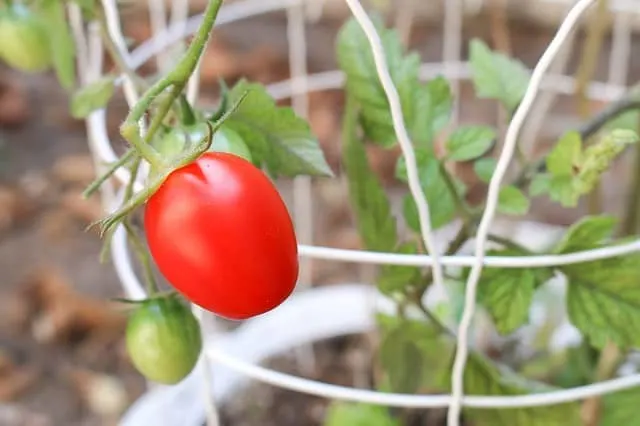
Many people believe that the capability to grow food is limited due to the lack of space in their homes.
Yes, you may not have a large yard or 40 acres of land to produce a lot of vegetables, but in reality, you don’t even need that much space.
A small deck around your home or even a tiny balcony is more than enough to grow enough produce to provide a steady supply for your guinea pigs.
One of the major things that depend upon whether you are growing in a container or in a big yard is the type of vegetables and fruits you can grow.
Yes, growing a large tree of apple or orange might not be possible in a container garden in the balcony.
However, you can still produce a wide range of vegetables like lettuce, cilantro, cucumber, etc. and fruits like strawberries, black currant, etc.
Usually, growing in a small space comes with a challenge, and the challenge is to get the maximum output from that small space.
One of the pro tips that I can share with you will be to use a companion planting. It is a widely used gardening technique where we plant a combination of several vegetables and herbs in a single pot.
However, make sure you look out for the needs of the plant while planting them together.
The need for sunlight, water, and soil conditions must be taken into consideration while using this technique.
Some of the great companion planting options would be:
- Beans, Carrots, Squash
- Eggplant, Beans
- Tomatoes, Basil, Cilantro
- Lettuce, cilantro or Parsley
- Spinach, chard, Beetroots
What supplies will we need to start growing food for our guinea pig?
Seed Starter Tray:
Seed starter tray is one of the most basic requirements to begin a vegetable garden.
It helps better the germination rate by creating a healthy environment for those seeds.
It is also essential to start the seeds early on inside our house before we shift it to containers.
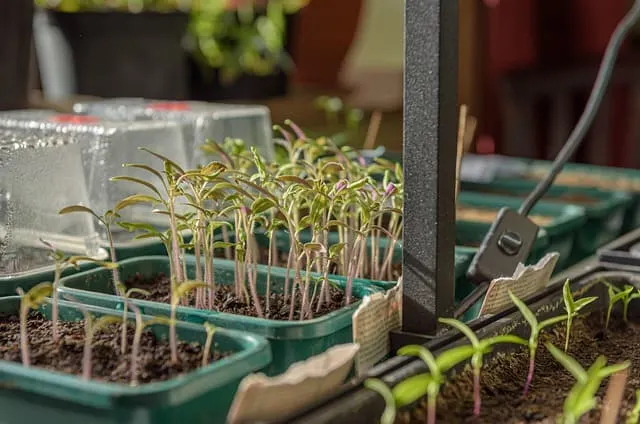
This ensures we have a head start every season(before final harvest) and produce more food consistently.
Growing pot:
Garden containers are yet another essential supply you would need to start producing vegetables for your guinea pigs.
Now, there is a wide range of pots available out there. Right from the Ceramic pots to Plastic containers and Even fabric grow bags.
I would highly recommend the fabric pots as they are environment friendly and easy to use.
You can easily place them around in your balcony, pot stand or even in a deck around your house.
Some of the most common sizes of pots that you should use are 7-gallon pots and 15-gallon pots.
Organic Soil:
Using good quality potting mix for your vegetable garden is really crucial.
Most new gardeners often lose hope in their garden when they don’t see good results, and having a good quality potting mix is one of the crucial factors that determine the success of the same.
Thus, make sure you get a good quality potting mix, to begin with.
The soil you get must be free from harmful chemicals and should have the right nutrients for proper growth.
Garden Tools:
Basic garden tools are yet other essentials you will need to begin a successful vegetable garden.
These tools have multiple uses right from transplanting the seedlings to digging, weeding, and aerating the soil.
There are a lot of sophisticated tools available for the same job, but these tools set would be a great one for the beginners.
Garden Pruner:
Garden pruners are one of the necessary tools for a new gardener. The pruner is used to harvest vegetables, cut down on stem plants, pruning large plants, and more.
Pruning plants that get laggy or grow slowly also helps in giving such plants a boost.
Make sure you use a good quality pruner for ease of pruning and excellent finish.
Gloves:
Gardening gloves are also essential to supply we need to begin our vegetable garden. A simple set of gloves can help protect your hands from sunburn, allergies, etc. It also helps prevent painful blister in our hands.
Watering Can:
Watering cans are another essential part of the supplies needed by someone who is starting a vegetable garden.
It can be difficult at times to connect a hose and water the plants, especially when we are trying to grow food on our balconies.
For such instances, small-sized watering cans come to the rescue. It doesn’t take much space, and it is straightforward to use and hide away from sight.
Indoor/Outdoor Metal Plant Stand:
Using the vertical space is really crucial when it comes to balcony or container gardening and using a metal stand like this could be a game-changer when you have a limited space to house plants.
You can place three 7 gallons containers on each of the tiers that give you a total of 12 containers in a single stand.
Using such stands to grow green veggies and herbs is an excellent way to get the most out of your available space.
Organic Seeds:
Last but not least, you will also need some good quality organic seeds to get started with the vegetable garden.
Try to get organic seed from the local farmer’s market or from a reputed vendor online.
Using good quality seed is essential for a good yield.
Make sure you use the companion planting idea while planting your seedlings to get the maximum output from your garden.
How long will it take to grow?
The growth rate of plants varies depending upon the type of plant you are growing, the environmental factors in your living area, and the care you provide.
While some vegetables like cilantro, Radish, Spinach, Etc, can be harvested within 30 days from the day of sowing while others like Carrots, Lettuce, and Bell pepper may take over 50 days before you can harvest any.
There are some easy to grow sprouts like Wheatcress and Watercress that can be prepared within a week as well.
The idea is to grow a mix of quick harvest and slow harvest crops to get a steady supply.
Fruits plants take longer to grow and bear any fruit.
Fruits like strawberries, raspberries, etc. might take up to 6 weeks before they are ready for harvest while other big trees take even years before bearing any fruits.
What are the benefits of growing own food for guinea pigs?
There are numerous benefits of growing your own food for your guinea pigs. Some of the major benefits include:
- One of the major benefits of starting your own food garden for your guinea pigs is savings on the monthly grocery bills. Guinea pigs need a consistent supply of vegetables that can add up to the cost pretty quickly.
- Growing their food also ensures the quality of the product is excellent, and it is free from all chemicals and pesticides. Thus, your guinea pigs shall remain happy and healthy.
- Sometimes it can be challenging to get supplies from the market, especially if your work schedule is too tight. Once you get started, your own food garden doesn’t take much time off your work hours.
- You will also save a lot of storage space as you have fresh produce right at your home. You won’t need a fridge full of vegetables for your guinea pigs. And the best part is it won’t run out every week.
- Gardening is a great stress reliever for some people. So, it might have a good impact on your mental health as well.
Easy to grow vegetables and herbs for guinea pigs
There is a wide range of vegetables that we can serve to guinea pigs. However, growing all of them is not possible.
Here is a list of some easy to grow vegetables and herbs for our guinea pigs:
Wheatgrass
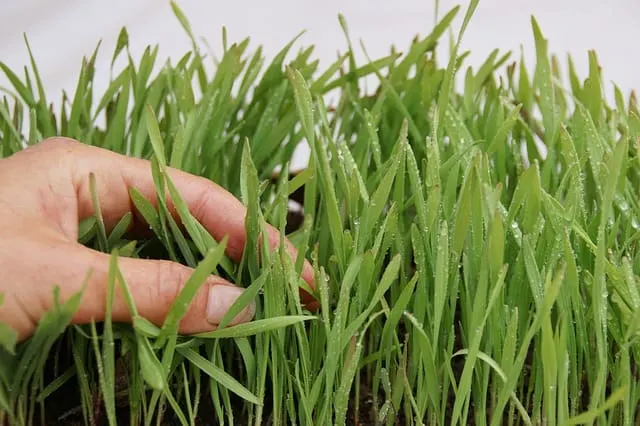
Wheatgrass is a great addition to our guinea pig’s diet. It is really easy to grow and doesn’t require much care.
Wheatgrass is an excellent source of Vitamin A, C, E and other essential nutrients including amino acids.
- Harvest time: 7-10 days
- Ease of care: Very Easy
- Container Size: Wide 12-18 inch container (2-3 pots)
- Serving size: A handful bunch 4-5 times a week
Cilantro
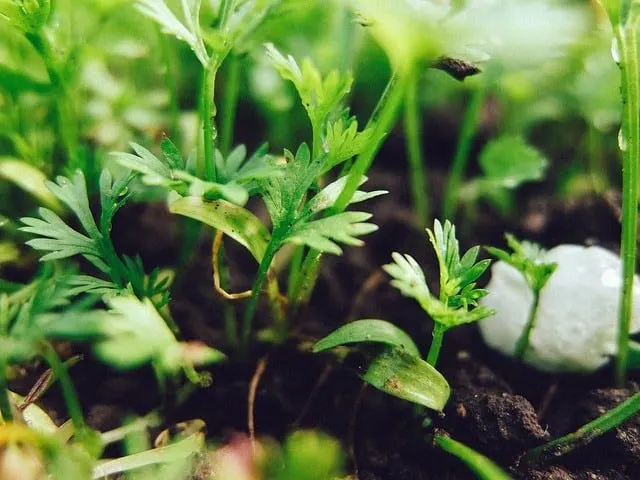
cilantro is also an easy to grow herb that is rich in Vitamin A, C, K, Folate and other nutrients. cilantro can be served almost daily in moderation.
- Harvest time: 30 days
- Ease of care: Very easy
- Container Size: Wide 12-18 inch container (2-3 pots)
- Serving size: 15-20 sprigs every day
Spinach
Spinach is also easy to grow green vegetables that can be served once in a while to our guinea pigs.
It is rich in Vitamin A, C, Iron, and other essential nutrients. Spinach does contain a moderately high amount of calcium in it thus it is recommended to serve sparsely.
- Harvest time: 30 days
- Ease of care: Easy
- Container Size: 7-gallon pot(1 pot)
- Serving size: 1 small leaf two times a week
Learn more about spinach from our in-depth article.
Carrots

Carrots are one of the most favorite vegetables that our guinea pigs enjoy the most.
Rich in Vitamin A, C, and other nutrients guinea pigs can eat carrots 3-4 times a week. Carrot greens are also a great snack for our guinea pigs.
- Harvest time: 40-50 Days
- Ease of care: Moderate
- Container size: 7 gallons (2-3 Pots)
- Serving size: One small-sized carrot 3-4 times a week.
Learn more about carrots from our in-depth article.
Cucumber

Cucumber is also a great addition to our guinea pig’s diet. Squashes like cucumber are mostly climbers and don’t require much space in the pots. Thus, makes a perfect companion plant.
Cucumbers contain Vitamins and minerals in it. It is also a refreshing and hydrating snack for our guinea pig.
- Harvest time: 55-65 days
- Ease of care: Moderate
- Container size: 15-20 gallons(1 container)
- Serving size: 1-2 small slice 2-3 times a week
Learn more about cucumber from our in-depth article.
Zucchini
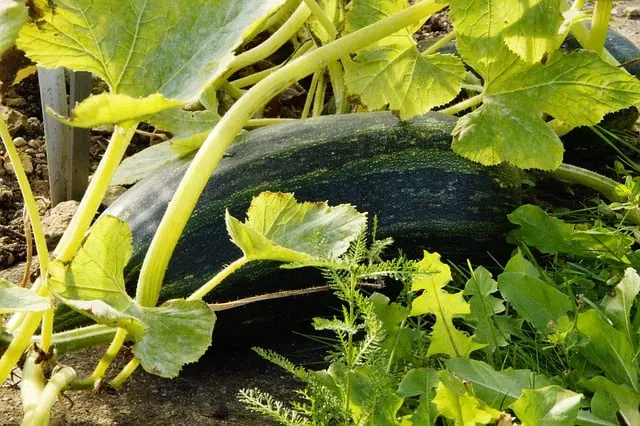
Zucchini is yet another summer squash that our guinea pigs love to munch on.
Although it doesn’t contain a lot of Vitamins and minerals in it, it still makes for an excellent snack in the summer.
Just like cucumber, zucchini is also a climber that require some support or trellis for proper growth.
- Harvest time: 40-50 days
- Ease of care: Moderate
- Container Size: 15-20 gallons(1 container)
- Serving size: 1-2 small slice 2-3 times a week
Learn more about zucchini from our in-depth article.
Lettuce
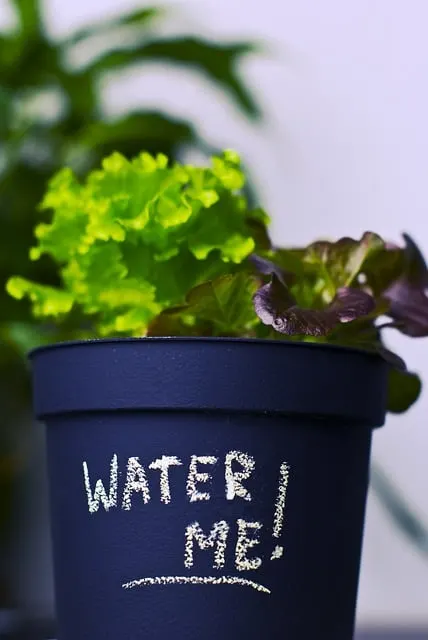
Lettuce is one of the staple vegetables in our guinea pig’s diet. There is a wide variety of lettuce available in the market.
Some of the most common and easy to grow lettuces are Green leaves lettuce and Red lettuce. Avoid other lettuces as they take a lot longer to grow.
- Harvest time: 45-55 days
- Ease of care: Moderate
- Container size: 7 gallons (One per container)(2-3 containers)
- Serving size: One leaf of lettuce every day.
Learn more about lettuce from our in-depth article.
Tomatoes
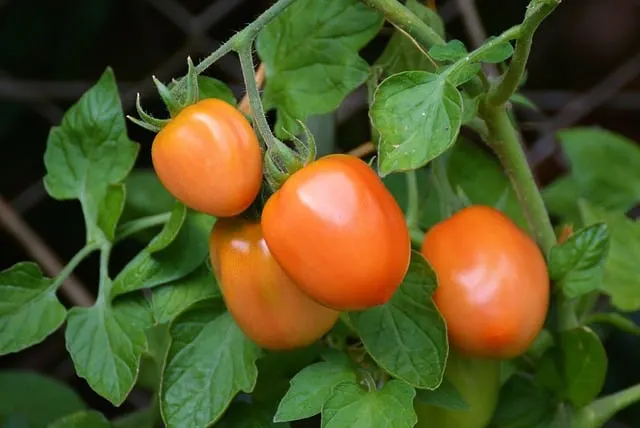
Tomatoes are also easy to grow fruit or perennials that grow throughout the year in some countries.
Rich in vitamins and minerals, we can serve tomatoes 2-3 times a week to our guinea pigs.
- Harvest time: 40-50 days
- Ease of care: Moderate
- Container Size: 7 Gallons (2 containers)
- Serving size: one small slice 2-3 times a week
Learn more about tomatoes from our in-depth article.
Watercress

Packed with Vitamin A, C, K, and other essential nutrients and antioxidants, Watercress makes for a perfect snack for our guinea pigs.
It also contains a decent amount of calcium in it and thus, should be served sparsely.
- Harvest time: 15-21 days
- Ease of care: Easy
- Container: 7 gallons (1 container)
- Serving size: 1-2 small leaves 1-2 times a week
Easy to grow fruits for guinea pigs
Fruits can be a challenge for most gardeners, especially when you have a limited space to grow the same.
The options are really limited when it comes to container growing. Some of the easy to grow container vegetables are:
Strawberries
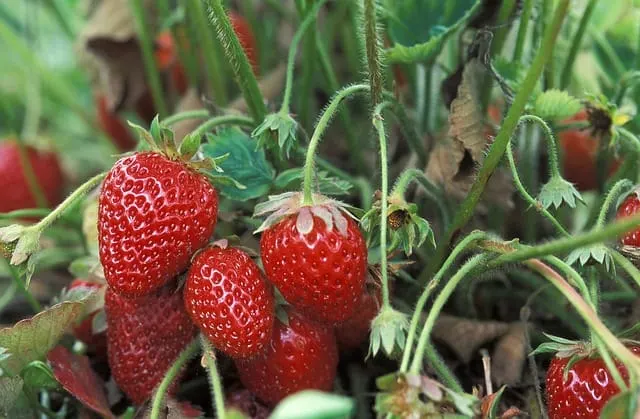
Strawberries are rich in Vitamin C, A, Iron, and other essential nutrients needed by our guinea pigs.
However, it is also a little high in sugar, which makes them a tasty treat if given in moderation.
Strawberries can be one of the easiest fruit to grow in a container garden.
- Harvest time: 30-45 days
- Ease of care: Moderate
- Container: 7 gallons (1 container)
- Serving size: 1 small piece once a week
Learn more about strawberries from our in-depth article.
Raspberries

Raspberries are also a great snack for our guinea pigs.
Packed with a punch of Vitamin A, C, & other vital nutrients it can be served to our guinea pigs once in a while.
However, it may take a long time to grow & thus a lot of patience is required.
- Harvest time: 13-15 months
- Ease of care: Moderate
- Container: 15 gallons (1 container)
- Serving size: 1 small piece once a week
Grapes
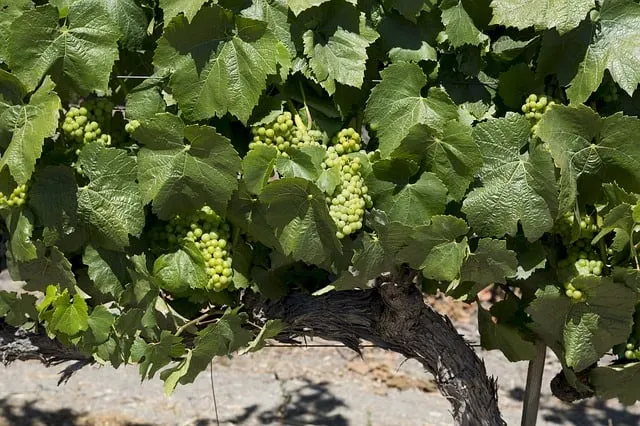
Grapes are also an excellent snack for our guinea pigs. A small piece of grape can make your guinea pig drool for more.
However, moderation is the key when it comes to serving fruits.
Grapes also contain a trace amount of essential vitamins and minerals, including Vitamin A, C & K in it.
Grapevines need a lot of support for proper growth as it grows vertically.
- Harvest time: 24-36 months
- Ease of care: Moderate
- Container: 7 gallons (1 container)
- Serving size: 1 small piece once a week
Learn more about grapes from our in-depth article.
Sources: Lettuce, Spinach, Parsley, Coriander, Watercress, Diet Composition and Mineral Balance in Guinea Pigs, Dietary Vitamin C, and Vitamin E on Guinea Pig Immune Responses to Mitogens, Vitamin C requirements of the guinea-pig, Is Your Guinea Pig’s Diet Providing the Right Nutrients? Care of Guinea Pigs, Growing Vegetables, VERTICAL GARDENING FOR VEGETABLES, Growing vegetables for home.
